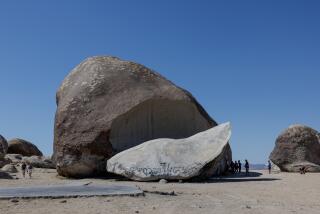Land Bureau Returns Afton Canyon Beauty
- Share via
It’s often called the Grand Canyon of the Mojave. High praise, indeed, but then Afton Canyon is a very special place--a geological wonderland sculpted by the Mojave River.
The U.S. Bureau of Land Management (BLM) is in the process of rehabilitating the canyon. Decades of off-road vehicle use tore up the ancient Mojave riverbed and gouged the surrounding hills. Overgrazing led to the invasion of such opportunistic plants as the tamarisk, which sucks up scarce water.
The bureau has rerouted off-road vehicles out of the canyon floor, eliminated grazing and begun to restore the native plant community.
Long ago, Afton Canyon was cut by outlet flow from a once-large body of water that geologists call Lake Manix. About 15,000 to 75,000 years ago, when a cooler and much more humid climate prevailed, wildlife was abundant around the lake, which was shallow but about 200 square miles in size.
Turtles, shellfish, camels, antelopes. It’s almost surreal to imagine a flock of pink flamingos, each standing on one leg, looking over a landscape that more resembles the Great Inagua of the Bahamas than the Great American Desert.
The Mojave River, during these wetter times and climes, must have been a river of considerable size. Even in today’s arid climate, the Mojave manages to flow below ground or above for 145 miles across the desert.
The (relatively) well-watered Mojave River Valley has always served as a route of travel. During prehistoric times, Indians traveled the Mojave Trail from the California coast to the Colorado River. DeAnza’s 1776 expedition passed through Afton Canyon on its way to Mission San Gabriel.
A half-century later, Jedediah Smith followed the Mojave and, after getting a bit exasperated with the river’s habit of disappearing underground for long stretches, called it, most aptly, the Inconstant River. Kit Carson took the river route, as did Charles Fremont, who gave the Mojave its name.
Today, the best view of Afton Canyon and the path of the Mojave River may belong to the crew of the Union Pacific freight train that rumbles through the canyon. An equally fine view is available to hikers. You can explore large Afton Canyon, and its many side canyons, including the largest of them, Pyramid Canyon.
Directions to trail head: From Interstate 15, 32 miles east of Barstow, take the Afton Canyon exit. Travel 3 miles south on a good dirt road to Afton Campground. Park at the campground, being careful not to take campsite space.
The Hike: Before you follow the Mojave River through Afton Canyon, you might want to cross it from the campground, under the first set of railroad trestles, and head south through Pyramid Canyon. The largest and deepest of Afton’s side canyons, 1 1/2-mile-long Pyramid Canyon is an easy stroll and a good introduction to the fascinating geology of the Afton Canyon area.
The grand rock walls, cut away by the once-mighty Mojave, gradually narrow until you reach what looks to be a dead end at the end of the canyon. Experienced hikers may want to scramble to the top of this “dead end” for a grand view of the surrounding desert landscapes.
Return to Afton Canyon and head upriver. You’ll note a grand assemblage of desert riparian growth--native cottonwoods and willows, along with the invasive tamarisk. Among the wildlife that frequents Afton Canyon are a variety of birds, including raptors--particularly golden eagles and red-tailed hawks--and the desert bighorn sheep.
Continue hiking up-canyon on the north wall for breathtaking views of water-eroded formations and to explore the many side canyons. These canyons are, for the most part, indicated by culverts; look for those at numbers 192.99 and 194.65. A flashlight is useful for finding your way.
Beyond this point the canyon widens and holds less interest for the hiker. Afton Canyon extends a few more miles to a double trestle bridge near Cave Mountain. For a different perspective of the canyon, you might consider returning via the river bottom rather than the north wall.
Afton Canyon Trail
Afton Campground to Pyramid Canyon:
3 miles round trip
Afton Campground to Side Canyons:
6 1/2 miles round trip
More to Read
Sign up for The Wild
We’ll help you find the best places to hike, bike and run, as well as the perfect silent spots for meditation and yoga.
You may occasionally receive promotional content from the Los Angeles Times.






